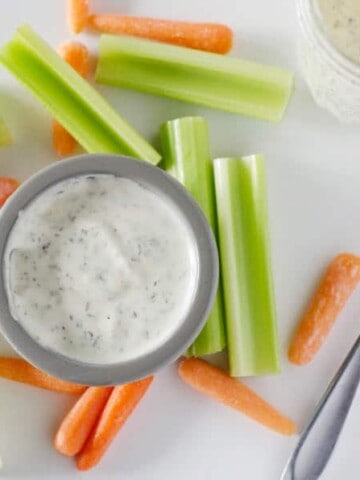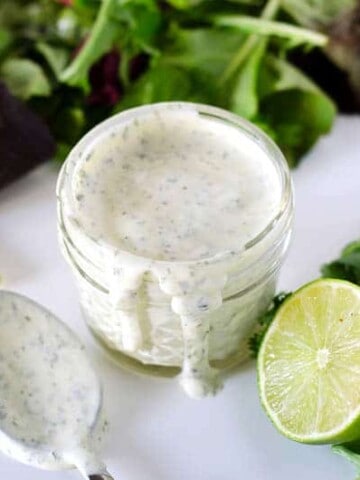Making homemade mayonnaise is easier than you think! Here is everything you need to know about the process.

What goes in homemade mayonnaise
Homemade mayonnaise is based on two simple ingredients - a whole egg and neutral-flavored oil. Recipes will vary from there, but those are your two essential ingredients.
My recipe for homemade mayonnaise includes fresh lemon juice, vinegar, and some spices.
You may find other versions that include only the egg yolk, and use oils such as light olive oil. More on that below.
The secret to making homemade mayonnaise
There's one, big, giant secret step to making homemade mayonnaise: your ingredients all have to be the same temperature.
Mayonnaise is an emulsion. That's sciencey, but really what it means is that colder and warmer ingredients can't combine themselves together. Making sure your egg and oil/liquids are all the same temperature is the secret to success. A room temperature egg and oil is usually the best combo.
This is the golden rule...but there's a way around it. This rule applies when you are making mayonnaise in a regular blender or food processor. When you're using a stick blender - you can pull that egg right out of the fridge and get to work.
How to make homemade mayonnaise in a regular blender or food processor
Making homemade mayonnaise in a regular blender or food processor is a very time-consuming endeavor. I liken the activity to being about as fun as watching paint dry, with a slight bit of excitement at the end when the mayonnaise actually comes together. Just be forewarned, you cannot do ANYTHING ELSE other than make your mayo for about 10 minutes.
Always remember the golden rule: make sure your ingredients are all the same temperature.
From there, add all ingredients except the oil to the food processor or blender, put on the lid, and open the top vent hole.
Make sure your oil is in a measuring cup with a spout. Don't drink too much coffee before, because you're going to need a SUPER steady hand.
Now - turn the blender or food processor on and as carefully and AS SLOWLY as you can, pour the oil in in the smallest steady stream you can muster. This part should take you 5-7 minutes, and I'm not joking on that. It's going to feel like a long time - because it is.
Skinny stream. Thin stream. Slow. Focus your mind on the movement of a sloth - they move 15 meters per minute. That is S L O W. As you pour, the mayonnaise will start to come together and you will hear the sound change. This does NOT mean you are done - don't just dump the rest of the oil in, or it will break the mayonnaise and all your hard work will go to waste.
Continue to pour in a minuscule stream until you are out of oil, then turn off the machine. You now have mayonnaise.
For reference, I have successfully made this with this Ninja blender and this Cuisinart food processor.
How to make homemade mayonnaise with an immersion blender
Ok, this is where this becomes a life-changing experience. You don't need $100 blender or a $200 food processor or 10 minutes of your life spent staring at your hand. All you need is an immersion blender and a flat bottomed container (I like to use these wide-mouth mason jars, but a measuring cup that your immersion blender fits into will also work!)
If you don't have an immersion blender, otherwise known as a hand blender or stick blender, get one. It makes so many things in the kitchen so much easier. Trust me on this one. It's less than $30 and is worth its weight in gold.
Put everything in one container. Egg, oil, lemon juice, seasonings, whatever. Just dump it in.
Now stick your immersion blender all the way down in the bottom of the jar and run it. Pulse if you like. Keep it in the bottom until you feel it start to thicken, then you can move it around/up/down a bit to get the rest of the oil incorporated.
You should have mayonnaise in less than 30 seconds. Told you it was worth it.
Oils you can use to make homemade mayonnaise
Oil is the main ingredient in mayonnaise. When making mayonnaise, you need a neutral flavored oil. I prefer to use avocado oil, but you can also use something like high oleic safflower oil, which is a slightly cheaper alternative.
While I don't recommend options like canola oil, soybean oil, grapeseed oil or vegetable oil for health reasons, you can use these and get the right results with the mayonnaise.
You cannot use regular olive oil or extra virgin olive oil. The flavor is simply too strong and you will not enjoy the taste of mayonnaise made with it. Trust me on this one.
If you are going to use olive oil, you need to use "light tasting" olive oil. You can buy this at the store, however, keep in mind that it is typically olive oil that has been cut with other oils.
(If you want the real skinny on all things olive oil, including the one I recommend and why, check out my post here all about how the mafia is involved in the olive oil industry. Not joking.)

Why your homemade mayonnaise is runny
If you tried to make homemade mayo, and it just turned into a creamy oil but never thickened, it failed. Do NOT continue to run the blender in hopes that it will "eventually" thicken. It won't. Sadly, if it doesn't happen in those few magical moments, they're not coming.
The most common reason for failed mayo is that the ingredients were not the same temperature at the time of mixing. Mayonnaise is made using a process called an emulsion. During an emulsion, for the best results, all the ingredients need to be the same temperature when combined in order for it to work. If one is warm and one is cold (think, pantry oil and refrigerated egg), then it will usually fail.
Never fear! You did not just waste an egg and all that oil. Don't toss it, we can save it.
How to recover your runny homemade mayonnaise
Sometimes, when making mayonnaise, it just....doesn't work. To recover your broken mayo, you're going to make more mayo. Instead of oil, you're going to use the failed runny mayo in place of it.
Get another egg. At this point I would make sure it's the same temperature, NOT a cold egg straight out of the fridge. Then when the egg is ready, pulse the egg and then pour in the failed mayo while blending, as if it is just plain oil.
It should come together into a creamy texture. Sometimes it does fail a second time. I'll be honest, at that point I let it go and start over. You can try again, but at that point the chemistry gets a little wonky.
Your recovered mayo will not be as thick as an original batch, but it will still get the job done!
How to know when it's time to start over
Ok, so you tried to make homemade mayo and it failed. Then you used the recovery technique above, and it still failed. What to do?
Usually at this point my spirit has been broken. I try to remind myself that tomorrow is another day. I ditch the batch of mayo and promise myself I'll get it next time.
Will I get sick from the raw eggs in my homemade mayonnaise?
I cannot definitively say that you will not.
I can, however, tell you that in all my years of making homemade mayonnaise, with both eggs from the grocery store and fresh eggs from local farms and eggs from friend's chickens, I have never ever once gotten sick from mayonnaise.
If you really want to, you can make a pasteurized egg. This is not something I have ever done, nor wish to do. Baking Bites has a great tutorial here on how to make pasteurized eggs, if it's something you're concerned about and want to try.
For me, that is not a step that has ever been worth it - the risk is very small.
The best options for store-bought mayonnaise
Maybe you don't want to start over tomorrow. Maybe you've decided, the hell with it, I'm done with this homemade mayo business! Just tell me what mayo I can buy that is free of nasty junk ingredients and highly processed oils.
Most conventional mayo contains cheap oils, preservatives, and shelf stabilizers. I try to keep as many of these out of our food as possible.
When I have to buy store mayo in a pinch, I hit up Amazon for either the Primal Kitchen mayo or the Chosen Foods mayo. I've also been able to find the Chosen Foods mayo at Costco once or twice, but that will vary with store and with season.
Ways to use your own homemade mayonnaise

Ok, I'm telling you, the mayonnaise you make is NOT the same as store-bought mayonnaise. If this is your first time making mayonnaise, you're going to be blown away by the flavor difference. I like to use it as salad dressing. Especially on a bed of spinach, topped with tomatoes and homemade bacon...it's like a BLT salad!
You can mix it with some dijon mustard for this sweet potato salad recipe, add it to chicken salad, or tuna salad. It's honestly one of the most versatile condiments out there. Here are some other great recipes that I use my delicious homemade mayonnaise for!
Recipe

How To Make Homemade Mayonnaise
Making mayonnaise at home is super easy and tastes so much better than buying it at the store! Here's how to make your own in a few simple steps.
Materials
- 1 egg
- 1 ¼ cups avocado oil
- 2 tablespoon lemon juice
- ½ teaspoon mustard powder
- ½ teaspoon Diamond Crystal salt
Tools
- Mason jar
- stick blender
Instructions
- Combine egg, ¼ cup of the oil, lemon juice, mustard powder, and salt in the mason jar.
- Place the immersion blender in the bottom of the jar and pulse.
- While running the immersion blender on low, pour the rest of the oil into the jar.
- When you hear the sound change, start to pull up the blender to incorporate all the oil .
- Run and pulse until mayonnaise is thick and the desired consistency, being careful not to overmix.
Notes
If you are going to make mayonnaise in a blender or food processor and not with an immersion blender, you will need to follow the instructions outlined in the post. This is a longer and more time consuming method, but is still doable, so don't lose heart! Just take your time and be patient.
Recommended Products
As an Amazon Associate and member of other affiliate programs, I earn from qualifying purchases, at no additional cost to you. Thank you for your support!










Leave a Reply